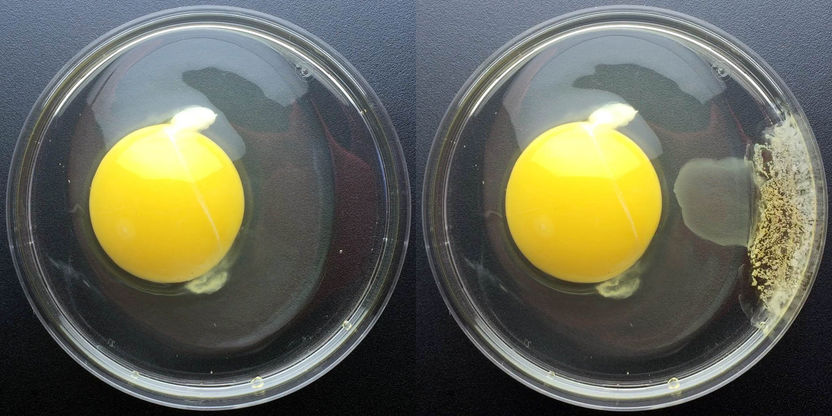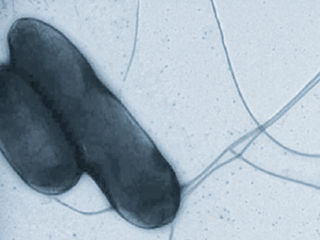Researchers discover protein protecting against chlorine
RidA protects intestinal bacteria from immune activity
Advertisement
chlorine is a common disinfectant that is used to kill bacteria, for example in swimming pools and drinking water supplies. Our immune system also produces chlorine, which causes proteins in bacteria to lose their natural folding. These unfolded proteins then begin to clump and lose their function. RUB researchers headed by Prof Dr Lars Leichert have discovered a protein in the intestinal bacterium E. coli that protects bacteria from chlorine. In the presence of chlorine, it tightly bonds with other proteins, thus preventing them from coagulating. Once the danger has passed, it releases them again and the proteins can continue to work as usual. The researchers report their findings in the current issue of Nature Communications.

Chlorine bleach unfolds proteins. Pictured on the left is an untreated egg; on the right the same egg after application of a drop of chlorine bleach. The chlorine bleach causes the proteins in the egg albumen to coagulate.
© RUB, Abt. Biochemie der Mikroorganismen
Cells under oxidative stress
The researchers look into oxidative stress, which affects cells when they encounter so-called reactive oxygen species. Oxidative stress plays a role during cell aging and in the immune defence. By producing reactive oxygen species, immune cells subject bacteria to oxidative stress. But what happens inside those bacteria, and more specifically, what happens to their proteins? The researchers searched to answer this question by looking for proteins that change due to oxidative stress. This is how they discovered the protein RidA.
RidA changes its function in the presence of chlorine
“Each protein has a function,” explains Lars Leichert. “RidA’s function is to ensure that intermediates occurring during the generation of certain amino acids get broken down more quickly.” In order to find out what happens to RidA under oxidative stress, researchers subjected RidA to a variety of reactive species normally generated by immune cells, including chlorine. Certain reactive species deactivate RidA, i.e. the intermediate would no longer be degraded by RidA, just as expected. But when RidA was treated with chlorine, the intermediate was not generated at all. “This means that chlorine-treated RidA must bind tightly to the protein that generates the intermediate,” explains Alexandra Müller from Leichert’s team. In other words: in the presence of chlorine, RidA transforms into a so-called chaperon.
With RidA the protein solution remains clear
As a chaperone it can protect other proteins: when proteins unfold – they do so, for example, if they are subjected to chlorine or are heated –, they coagulate. As a result, the protein solution becomes cloudy. “In an egg, this is particularly impressive. When cooked, the transparent egg albumen turns white and opaque as proteins unfold,” describes Lars Leichert. The researchers are able to measure this cloudiness precisely with a fluorescence spectrometer. If chlorine-treated RidA is added, the same solution remains clear. Coagulated proteins do no longer function – no chick will hatch from a cooked egg. A chaperon can prevent this coagulation, thus protecting the cell.
Sticky protein bonds with all other proteins
The researchers moreover discovered that, after the threat posed by chlorine has passed, RidA has the capacity of releasing the proteins again, so that they can regain their function. If chlorine poses a threat once again, RidA bonds with proteins once again. Furthermore, the researchers examined, how exactly RidA becomes a chaperon. Experiments showed that so-called N-chlorination causes RidA to become more hydrophobic. The more hydrophobic a protein is, the “stickier” it becomes and the better it can bind unfolded proteins. In its sticky state, RidA protects the proteins in the bacteria cells from coagulation.
Researchers suspect it plays a role in immune defence
However, this has no consequence for using chlorine as a disinfectant: RidA helps bacteria only when the chlorine concentration is very low. Unlike with antibiotics, there are no resistances against disinfectants. “We believe that chlorine-activated chaperons play a role when bacteria and immune defence collide,” says Lars Leichert.
Original publication
A. Müller, S. Langklotz, N. Lupilova, K. Kuhlmann, J. Bandow, L. Leichert (2014): Activation of RidA chaperone function by N-chlorination, Nature Communications























































